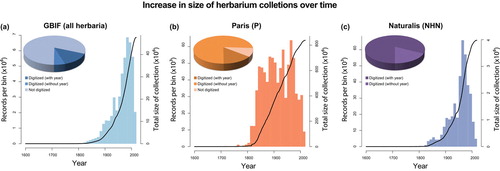Figures & data
Figure 1. Trends in the number of digitized plant specimens available in global herbaria. (a) Growth of specimen collections in global herbaria over time. All data on all “preserved specimens” in the kingdom Plantae were obtained from the Global Biodiversity Information Facility (GBIF), yielding 64.7 million records, of which 48.5 million (75%) contained metadata about the collection year. (b) Growth of the vascular plants collection (P) at the herbarium of the Muséum National d’Histoire Naturelle (MNHN, Paris) over time. Altogether, 5.4 million (90%) of the estimated 6 million specimens from P are databased in GBIF, of which 0.838 million (15%) contain information about the collection year. (c) Growth of the Naturalis Biodiversity Center (NHN, Netherlands) collections over time. All 4.8 million specimens from Naturalis are databased in GBIF, and 0.832 million (17%) of these contain no information about the collection year. In each panel, the bars show the number of specimens collected in each 10 year period, while the black line indicates the cumulative total number of collected specimens. The general trend shows an increasing rate of global specimen deposition starting from 1800, with very few specimens collected before that year. The growth rate of herbarium collections dropped markedly during the periods of World War I and World War II. During the last 30–40 years, the rate of specimen deposition has decreased, although it is not clear whether this reflects a real effect or a time lag or bias in digitization efforts. It is important to note that for many historical herbarium specimens, the precise collection date may be unknown, although often an approximate collection date can be gleaned from associated historical records (e.g. plants collected during a botanical expedition in 1804–1806). Therefore, although this information is missing in the GBIF database, those specimens could still be valuable in a study of temporal genetic variation.

